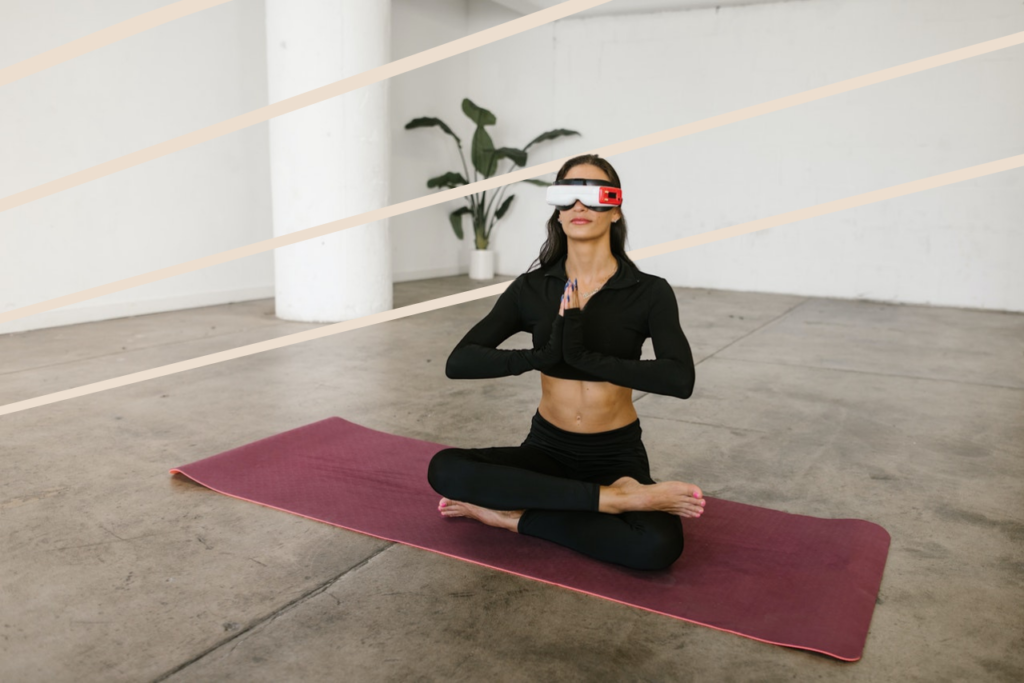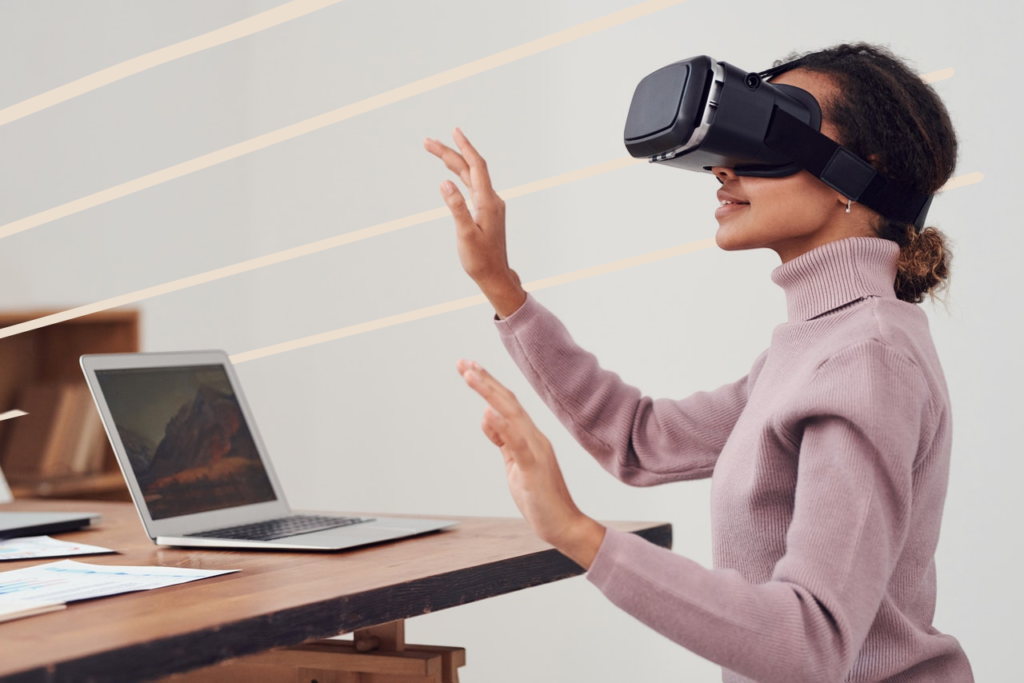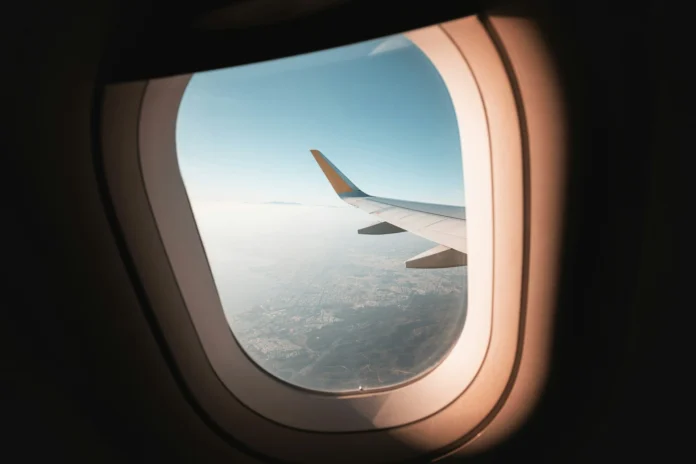Though the scope of what virtual reality (VR) and augmented reality (AR) headsets can do feels limitless, thus far their potential – at least, the public perception of their potential – has largely been confined to the high-tech world of gaming.
In fact, there are many different reasons why people might want to invest in VR or AR technology, with uses ranging from entertainment all the way to education. Today, we’ll delve a little deeper into this fascinating world that’s just brimming with possibilities. So, put on your headsets and buckle up; here are 12 uses for VR & AR headsets beyond the world of gaming.
Entertainment & Media
Entertainment is one of the main reasons why people buy VR headsets. Whilst video games are the chief driver of VR headset sales (global VR video gaming revenue reached £22 billion in 2020), VR can also be used to watch films in a completely new way to how you typically experience them when using a regular television screen. Immersiveness here is everything.
The advancements in hardware and pricing of VR headsets have made the prospect of a truly immersive home (or on the go) cinema experience accessible to the masses. The ability to entirely tune out the external world was a key selling point of the Apple Vision Pro when it was launched, and it’s easy to see why. True immersion in your media of choice has never been easier thanks to VR, and it won’t be long until it is the medium of choice entertainment purposes, both at home and while travelling.

Sports Entertainment & Live Events
The world of sports entertainment has been revolutionised by both VR and AR technologies. Virtual reality allows fans to experience live sporting events from the best seats in the house, without ever leaving their living room. Imagine watching a Premier League match from the manager’s dugout or experiencing the thrill of Centre Court at Wimbledon from a courtside perspective.
Even online casinos are getting in on the action, offering immersive VR poker rooms and virtual racecourses that put you right in the heart of the betting action. This convergence of sports, gaming, and virtual environments exemplifies how entertainment in the metaverse is blurring the lines between physical and digital experiences, creating entirely new forms of interactive entertainment that combine the thrill of live sports with the convenience and customisation of virtual worlds.
The portability of modern VR headsets has been a game-changer for sports and gaming enthusiasts alike. Fans can now play on the go, placing bets on virtual races during their commute or enjoying a quick poker session while travelling. This mobility has transformed VR from a stationary home experience into something that fits seamlessly into busy, mobile lifestyles, opening up new opportunities for entertainment wherever and whenever users choose.
Tours & Holidays
Virtual tours can be set up on some of the most popular tourist destinations on the planet, such as Disney World or Universal Studios, to allow people who cannot travel there in real life to see what it is like and experience it in an immersive way. For tour operators and companies, this can be a positive marketing tool, as it works as an advert, potentially drumming up interest in travelling there.
Similarly, virtual tours can now be set up for customers to experience different hotel rooms or locations before booking a trip. AR applications take this a step further, allowing tourists to point their devices at landmarks and instantly receive historical information, translations of signs, or recommended nearby attractions.
The potential of virtual and augmented reality experiences within the hospitality and tourism sector is limitless, as upcoming technologies will allow for even more immersive experiences. One wonders if, in the world of future travel, we’ll even need to leave our homes at all.
Hmmm, actually that sounds a little dystopian. Anyway…

Museums & Galleries
Museums and galleries are also potentially lucrative markets for VR and AR headsets. One of the biggest reasons is that many sites worldwide already have 3D models of their exhibits, which makes viewing them in a virtual environment much easier. It also allows people to explore presentations about specific topics that they’re interested in.
Read: 10 IDEAL virtual tours of London landmarks
AR technology has become particularly valuable in this sector, allowing visitors to point their devices at artwork or artefacts to receive detailed information, see historical context, or even watch the pieces come to life through animation. Some museums have even started creating online courses that people can take without ever leaving their homes, opening up new possibilities for education that were not possible before.
Education & Training
In education, virtual reality headsets can allow students to experience different aspects of historical events or geographical locations without physically going there. In addition, using VR headsets can help them learn more about a specific topic through guided tours and interactive activities. Meanwhile, AR applications can transform traditional textbooks into interactive learning tools, with 3D models and animations appearing above the pages.
The huge benefit of virtual and augmented reality in the field of education is that classes will be immersive and inspiring, evoking a sense of awe and wonder in students that a blackboard simply can’t. These technologies in schools have the potential to boost student engagement, enhance the capacity for (and effectiveness of) experience-based learning, and even allow for virtual field trips to take place.
Not only applicable to tertiary education, VR and AR can also be used for the purposes of training at work, too. Companies are increasingly using these technologies to provide immersive, hands-on training experiences that would be too costly or dangerous to replicate in real life. Read more about eLearning.
Fitness & Exercise
The fitness industry has embraced VR and AR technology as a game-changer for home workouts and gym experiences. VR fitness applications transform monotonous exercise routines into engaging adventures – imagine boxing against virtual opponents, climbing mountains in fantastical worlds, or dancing in immersive environments that make you forget you’re working out. Popular platforms like Supernatural and FitXR have turned cardio sessions into rhythm-based experiences that feel more like entertainment than exercise.
What makes VR fitness particularly effective is its ability to address common workout barriers. The immersive nature helps users overcome gym anxiety by exercising in private virtual spaces, while gamification elements provide the motivation that many struggle to maintain with traditional routines. Users can track calories burned, compete on global leaderboards, and join live classes with participants from around the world – all from their living room.
AR technology is equally transformative for fitness enthusiasts. Runners and cyclists can use AR glasses to display real-time performance metrics, navigation routes, and even virtual pace partners in their field of view. Smart mirrors with AR capabilities can demonstrate proper form, count reps, and provide real-time coaching feedback during strength training sessions. Some apps even overlay virtual trainers into your actual workout space, providing personalised guidance without the cost of a personal trainer.
The psychological benefits are substantial too – the immersive distraction of VR can make intense workouts feel shorter and more enjoyable, while the variety of virtual environments prevents the boredom that often derails fitness goals. As these technologies continue to evolve, we’re likely to see even more innovative approaches to making fitness accessible, enjoyable, and effective for people of all fitness levels.
Work & Professional Purposes
VR and AR headsets are also currently being used for work purposes, such as training simulations. If you are an astronaut or aeroplane pilot, for instance, you can use VR to practice specific tasks without going through the actual job first, potentially saving lives and money.
A VR headset can allow technicians to virtually walk around their work environment in 3D without having to leave the comfort of their couch or office chair, allowing for meetings and colleague interaction in a more consuming, meaningful (and worryingly invasive) way. AR, on the other hand, can overlay crucial information onto real-world machinery or equipment, helping technicians with maintenance and repair work.
This technology has the potential to be particularly useful in the real estate market, as virtual tours of properties can take place in an efficient, resourceful way.
Finally, the use of virtual reality in engineering possesses perhaps the most exciting potential of all. These technologies are already well-established tools in precision engineering, helping enhance design efficiency, visualise model buildings, and transform factory processes.
Military & Defense Applications
VR and AR headsets are also used by military personnel to train soldiers on how to react in certain situations that they may encounter. Many militaries worldwide have already started using VR to train their soldiers, and, likely, this number will only go up in the future.
AR technology is particularly valuable in combat situations, providing soldiers with real-time battlefield information, navigation data, and threat detection through heads-up displays. Interesting stuff, indeed, though the morality of using these technologies in combat is highly questionable.

Retail & Shopping Experiences
One of the most practical applications of AR technology is in the retail sector. Shoppers can now use AR apps to visualise how furniture would look in their home, try on clothes virtually, or see how makeup would look on their face before making a purchase. This technology is transforming the online shopping experience, reducing returns and increasing customer satisfaction.
For retailers, AR can help with inventory management, store layout planning, and providing interactive product information to customers. VR, meanwhile, is being used to create immersive shopping experiences, allowing customers to browse virtual stores from anywhere in the world.
Medical & Healthcare Purposes
Medical uses of VR and AR headsets are definitely on the rise. One recent trial saw patients wearing VR headsets to help them to relax during surgery, sometimes in place of sedatives.
The potential for virtual reality to help patients get over phobias, such as fear of flying or heights, is also being explored. Virtual reality can also be used to reduce pain and anxiety in patients who have PTSD and other psychological disorders, though studies into the efficacy of this are ongoing.
AR technology is revolutionising surgical procedures, allowing surgeons to see vital information, patient data, and 3D anatomical models overlaid onto their field of view during operations. There is even the potential for VR and AR to be used as diagnostic tools in some cases, giving doctors new possibilities for examining patients.
Architecture & Design
VR and AR headsets have become invaluable tools for architects, interior designers, and urban planners. Virtual reality allows clients to walk through buildings before a single brick is laid, experiencing the scale, flow, and atmosphere of spaces in a way that 2D plans and renders simply cannot convey. This immersive preview capability helps identify design flaws early, saves costly modifications during construction, and ensures clients are genuinely satisfied with the final vision.
AR technology takes this further by allowing architects to overlay proposed designs onto existing sites. Interior designers can use AR to show clients exactly how different furniture arrangements, colour schemes, or materials would look in their actual space, eliminating the guesswork from design decisions.
For urban planners, these technologies offer the ability to visualise how new developments will impact cityscapes and present proposals to communities in an accessible, engaging manner. As the architecture and design industries continue to embrace these technologies, the gap between imagination and reality grows ever smaller.
Social Interaction & Communication
The latest frontier for VR and AR technology is in social interaction and communication. Virtual reality platforms are creating new ways for people to socialise, attend events, and maintain long-distance relationships through immersive virtual environments. Users can create avatars, attend virtual concerts, participate in social gatherings, or even conduct business meetings in shared virtual spaces.
AR is enhancing real-world social interactions by providing contextual information about the people and places around us, translation services for cross-cultural communication, and new ways to share and experience content together.
The Bottom Line
Virtual and augmented reality headsets allow people to experience and do things that they usually would not be able to do. While it may take some time for this technology to become the norm, it has already been adopted by multiple sectors.
As new companies enter the market and offer more affordable alternatives, we expect VR and AR headsets to become more ubiquitous, diversifying their potential and making them more accessible to the general public. We can’t wait to see (through our VR or AR headset) what the future brings!





